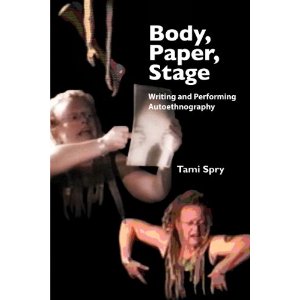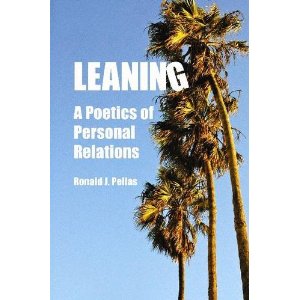Body, Paper, Stage
 Spry discerns the purposes, premises, and processes of performative autoethnography. Throughout, she describes the techniques of “putting the body on the page” and “lifting it to the stage” (p. 26), highlights complications, epiphanies, and paradoxes of performative autoethnography, and believes that performative autoethnography should “open up ‘different modes of living’ for others” (p. 124).
Spry discerns the purposes, premises, and processes of performative autoethnography. Throughout, she describes the techniques of “putting the body on the page” and “lifting it to the stage” (p. 26), highlights complications, epiphanies, and paradoxes of performative autoethnography, and believes that performative autoethnography should “open up ‘different modes of living’ for others” (p. 124). Spry has a talent for discerning and describing characteristics of performative autoethnography. In particular, she says that performative autoethnography shows the “messy beauty of being with others” (p. 27), documents a person’s “engagement with cultural codes and expectations” (p. 49), consists of agency (the ability to tell a story) and representation (accountability to the story told; p. 53), and tries to turn the “internally somatic into the externally semantic” (p. 63). She says that performative autoethnography is embodied (manifest in physical beings/bodies), co-performed (constituted by and situated in interaction with others), evocative (tied to emotion, sense-making, and articulation), and consequential (has transformative possibilities; p. 103). And she says that performative autoethnography resides in the “ontological tension between its epistemological potential and its aesthetic imperative” (p. 109)—between providing insight into and knowledge about cultural phenomena while simultaneously offers an engaging, well-crafted text or performance.
I appreciate Spry’s commitment to self-awareness and social justice—a commitment echoed throughout the book. She argues that performative autoethnography should interrupt, refute, and intervene in “dominant narratives” (p. 69), “articulate the collisions and collaborations with others” (p. 57), call attention to “social norms and expectations” as well as show how bodies can transform these norms and expectations (p. 100), and “try and tell a different story” rather than perpetuate harmful, “taken-for-granted social assumptions” (p. 101). Spry offers the language and justification for engaging in critical self-reflection; we write and perform, she suggests, in order to “enhance our awareness of how our choices have conflicting effects upon ourselves and those around us” (p. 120).
I also appreciate Spry’s ability to encourage others, primarily students, to do performative autoethnography. She first describes the process: Begin by focusing “on an experience—or a series of experiences—that changed your life in some way, or that was somehow transformative in terms of how you think, act, or see the world” (p. 123). Then use existential fragments, clusters of ideas, thick description, research, metaphor, and fluctuations in time and space to organize these experiences in engaging, coherent, and insightful ways. She concludes by describing how to stage these experiences, noting that performance choices require an “interactive, back-and-forth engagement between the internal (thoughts, feelings, attitudes, emotions) and external (voice, body, and space) elements” (p. 191). While she recognizes that we might find writing, rehearsing, and performing intimidating acts, she works to quell such fear by saying that there is no need for innate talent or sophisticated, bourgeoisie training. Do not be afraid, she suggests. As long as dedication and discipline exist, the ability to do performative autoethnography is possible; the most difficult work happens in the “labor of analysis and preparation in rehearsal” (p. 184).
Given her commitment to self-awareness and social justice and her ability to write in an encouraging, non-intimidating way, Spry equips students with the ability to see the ways in which they, personally, can change intolerable contexts and conditions. She equips students with the ability to question, analyze, and realize the ways in which they are implicated by cultural norms. And she equips students with the ability to navigate various media—not just writing but also performing, not just the body on the stage but also the body in everyday life.
Leaning
 Pelias uses autoethnography, poetic inquiry, performative writing, and personal narrative to describe how bodies move—lean—together, placing themselves “in relationship to other bodies” (p. 9). He illustrates how “interpersonal schemes” impact relationships, sense-making, and ideas of self (p. 43) and shows why “leaning towards others carries the greatest potential for meaningful and lasting relationships” (p. 9). Throughout, Pelias shows how his body leans toward or away from others (e.g., friends and family members, restaurant servers, students) and in particular contexts (e.g., New Orleans, on the golf course, in the military), and he encourages us to listen and be mindful of our relational ties, to understand the “fragility of connection,” and to never give up trying to figure out what and who matters (p. 45).
Pelias uses autoethnography, poetic inquiry, performative writing, and personal narrative to describe how bodies move—lean—together, placing themselves “in relationship to other bodies” (p. 9). He illustrates how “interpersonal schemes” impact relationships, sense-making, and ideas of self (p. 43) and shows why “leaning towards others carries the greatest potential for meaningful and lasting relationships” (p. 9). Throughout, Pelias shows how his body leans toward or away from others (e.g., friends and family members, restaurant servers, students) and in particular contexts (e.g., New Orleans, on the golf course, in the military), and he encourages us to listen and be mindful of our relational ties, to understand the “fragility of connection,” and to never give up trying to figure out what and who matters (p. 45). Pelias has a talent for making cultural critiques by way of what might appear as innocent and mundane personal experience. For instance, in describing how he competently responds to others—evidenced by his ability to answer questions, use grammar in “correct” ways, and gesture with his body—he argues that such acts help define him, in others’ eyes, as “cooperative, relatively competent, and, by some measures, sane” (p. 20). I read subtle critiques in these words; to me, he suggests that different others—those who have a difficult time asking “proper” questions, using “correct” grammar, or gesturing in “appropriate” ways—might have trouble making do and getting by especially if these others are evaluated in negative ways, evaluations which can have material consequences (e.g., gaining employment, achieving education, being subjected to medical discourse).
In another section, Pelias writes about being trapped by “demographic labels” such as race, class, sexuality, and gender. “I am a man doing the best I know how,” he says, followed by “I keep that claim as my excuse” (p. 28). Another seemingly innocent and mundane critique: Pelias offers his excuse, saying that he’s doing the best he thinks he can. But he doesn’t stop there—he implicates himself again, suggesting that his comforting, “doing the best he knows how” excuse may not only be a privileged act but also a cultural sham.
Another strength of Pelias’s book is his ability to describe the body’s feelings and failings. In the chapter “Struggling for Speech,” he describes the tense body, the body in conflict, the “physically and psychologically heightened” body, the “momentarily speechless” body, the body that feels “inadequate,” “torn,” “doubled,” and “wondering” (p. 39, emphasis in original). In all three chapters of the section “Watching Men,” Pelias describes enactments of gender—of being a “girly man,” of (not) doing gender right, of trying to find and “adopt a [gendered] stance that manages power ethically and that settles into my body with comfort” (p. 105).
I also appreciate Pelias’s attempt to show how leaning in, of being actively attentive to and engaged with others, means trying to steer clear of assigning fault and blame. For instance, in a few places, Pelias writes about his estranged son and why he feels their estrangement happened: Pelias refused to bail his son out of jail, an act he had done a few times before. But here, in a moment where blame might seem easy—Pelias could blame his son for landing in jail again—he refrains from doing so. Instead, Pelias offers a complex description of their failed connection, never faulting himself as a father or blaming his son for his mischievous deeds but rather framing their estrangement in the context of the relationship.
Connection(s)
While significant differences exist between both books—Spry focuses on the nuances of writing and performing whereas Pelias focuses on the nuances of leaning with friends, lovers, and family; Spry’s text is more appropriate for undergraduates whereas Pelias’s text seems more appropriate for graduate students—these texts connect in remarkable ways.
Both would be appropriate for courses on performance studies, autoethnography, and qualitative research.
Both emphasize process—the process of writing and staging, of performing and relating, of making sense and missing connection, of learning and loving. In so doing, both highlight the craft of research and the craft of relating and illustrate why no representation or relationship can ever be final, only manifest itself in different ways.
Both show the “messy beauty of being with others” (Spry, 2011, p. 27), discern ways in which personal pains and confusions are tied to and constitutive of “larger sociocultural pains and confusions” (p. 36), and illustrate connections between identity and sociocultural contexts, with Spry discussing the personal/cultural implications of losing a child in childbirth and the complicated, mundane racial politics of her (White) father playing with a jazz band, of entering through the front door of hotel while the other (Black) band mates may have had to enter through the back, the embodiment of race and privilege manifest in entering, or being unable to enter, particular doors; and Pelias (2011) showing how age, sexual orientation, and race manifest themselves on Bourbon Street, arguing that “one had better, given who one is, be in the right relationships. One had better, given who one is, be in the right circumstances” (p. 136).
Both position the body as an “ideological and disciplined subject,” a “site that is worked upon and into a source for understanding” (Pelias, 2011, p. 107), and both show how “practiced vulnerability”—of being rehearsed but not too rigid—has a place not only in texts or on stages, but also in everyday life. Be attentive and rehearse, both suggest, but not too much.
Both are about bodies—controlling bodies, learning through/with bodies, leaning toward and away from others’ bodies—and both keep bodies moving, questioning, and reflecting, offering hope and encouragement in our abilities to do writings and performances that matter.
— Tony E. Adams , Northeastern Illinois University


